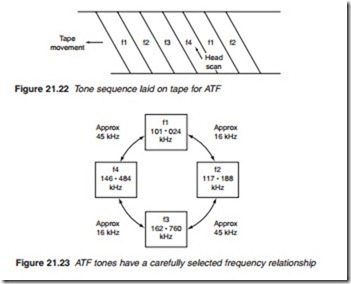Tracking
We have seen that during record, the phasing of the head drum position relative to the incoming video ensures that the field synchronising pulse is laid down at the beginning of each head scan of the tape. During replay, it is necessary to set and maintain the relative positions of the tape and head drum so that each head scans down the centre of its own track. The record phasing and replay tracking is carried out by the VCR’s servo systems. A control track is recorded along the edge of the tape as a timing reference. This takes the form of a 25-Hz pulse train and is used on replay to set and maintain the relative position of the tape tracks and head drum.
Automatic tracking is achieved by sampling the amplitude of the off- tape FM carrier signal and applying it to the servo circuit to ‘trim’ the tracking for optimum results. Even so, a manual override is provided, most often used in replay of hi-fi sound cassettes which are ‘difficult’, per- haps due to slight head misalignment in the duplicating deck on which they were recorded.
Automatic track finding
Automatic track finding (ATF) is a more advanced form of tracking, in which head-guidance signals are continuously recorded in the video tracks. The concept was first introduced in the now-defunct Philips/ Grundig V2000 format, where it was known as DTF and was used with a piezo-bar mounting system for the heads, whose position could be set by applying d.c. deflection voltages to the piezo bars.
Video-8 format uses an ATF system, the essence of which is a pilot tone which is recorded with the picture throughout every video track. Four pilot tone frequencies are used: f1, 101.02 kHz; f2, 117.19 kHz; f3, 162.76 kHz and f4, 146.48 kHz. They are added to the luminance FM record signal and recorded in the sequence f1, f2, f3, f4 in successive head sweeps (see Figure 21.22). Relatively low frequencies like these are almost unaffected by any azimuth offset of the replay head, so pilot-tone cross-talk from adjacent tracks is easily picked up by the video heads during playback. The pilot- tone frequencies are chosen to have specific relationships as Figure 21.23
shows. The beat frequencies which arise when pilot tones from adjacent tracks are mixed are always 16 or 45 kHz. These beat products are used to steer the head path/tape track alignment for optimum tracking: when the levels of 16 and 45 kHz beat signal are equal, the replay head must be scanning along the dead centre of its video track indicating optimum tracking.
There are several ways in which the ATF pilot tones can be processed during playback. A simple one, illustrated in Figure 21.24, utilises two band- pass filters to pick off and separate the 16 and 45 kHz beat products so that they can be separately detected and measured. The d.c. outputs are applied to the differential inputs of an operational amplifier whose output forms the error signal. This error output can be used to phase-lock either the capstan or head drum servo to give accurate and continuous tracking correction with built-in compensation for ‘mechanical’ errors, tape-stretching, etc.
